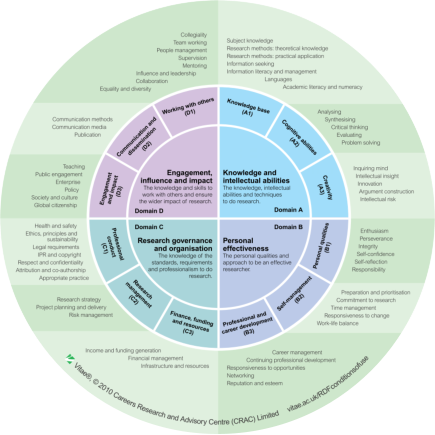



Researcher Development Framework (RDF) and Personal Development Reviews (PDRs)
Researcher Development Framework (RDF)
The Researcher Development Framework (RDF) is essentially an aid that researchers can use to more strategically approach their professional development. It was developed by fellow researchers who asked many professors “What makes a successful researcher?”. About 1000 characteristics were identified which were reduced to just over 60 and categorised accordingly into four main domains and further divided into twelve sub-domains. It is summarised in the image (click to enlarge). Vitae have produced a 5 minute video summarising this diagram and explaining what the RDF is all about. Full details about the RDF can be found on the RDF section of the Vitae website. Here, however, we will summarise how you can use it to strategically approach your development, particularly to help prepare for Personal Development Reviews (PDRs) or planning your career if a job change is coming up.Personal Development Review (PDR)
Personal Development Reviews will soon become mandatory in the university. Essentially you will sit down with your line manager / PI once a year and determine areas in which you can develop yourself professionally. It is important to note that PDRs are about being supported to form an action plan designed to help you take control of your professional development; they are not about someone else telling you what you should or should not be doing. A good way to prepare for a PDR is to use the RDF Planner outlined below. (Note: some more official documentation about PDRs can be found here.)Using the RDF, the RDF planner, and RDF
lenses
The Researcher Development Framework can help you identify how to improve target areas that you may be weak in or wish to strengthen further. The RDF Planner is designed to help you achieve this. This planner will be changed in the near future to be a fully online app, but as of now, the best way to learn how to use this is to watch this instructional video and use the downloadable Excel file. We’ll update this approach when the updated new online system is released. A further aid for using the RDF planner comes in the form RDF ‘lenses’. The RDF diagram above shows all the attributes determined to be required for success, but certain career paths will require focus on specific areas and skills. Lenses are designed to help you identify the most important of these areas for a particular career path. You can think of the lenses as a pre-made list of RDF settings suitable for various career goals. For example, the “employability lens” shows you how to use the RDF to develop the skills needed to be most employable outside higher education, as determined in the initial RDF formation research. A full list of the currently available lenses can be found on the Vitae RDF lenses page and include:- Employability lens Engineering lens Enterprise lens Information literacy lens Intrapreneurship lens Leadership lens Draft public engagement lens Teaching lens













Rev. 34


- Day-to-day topics
- University-wide services
- School-level services
- Support hubs
- General finance support
- Finance Systems team and Oracle Financials
- Registering to buy things on i-Proc
- How to buy things on i-Proc / eMarketplace
- IE, category, and task codes
- Set up a new i-Proc supplier
- Buy a new computer
- Central Stores
- Credit card purchases
- Petty cash
- One-off payment forms
- Expensive orders (over £5k)
- Finance Hub and Finance Manager meetings
- Conferences and travel
- Advances
- Expense claims






Home > Researcher development > RDF & PDRs












